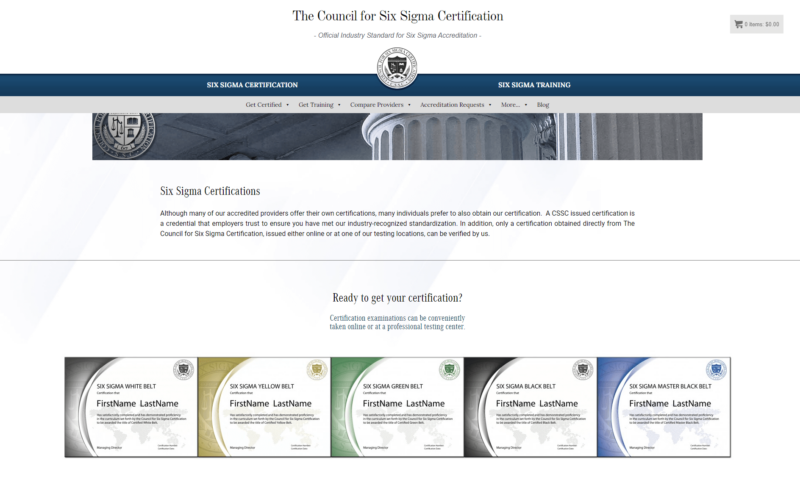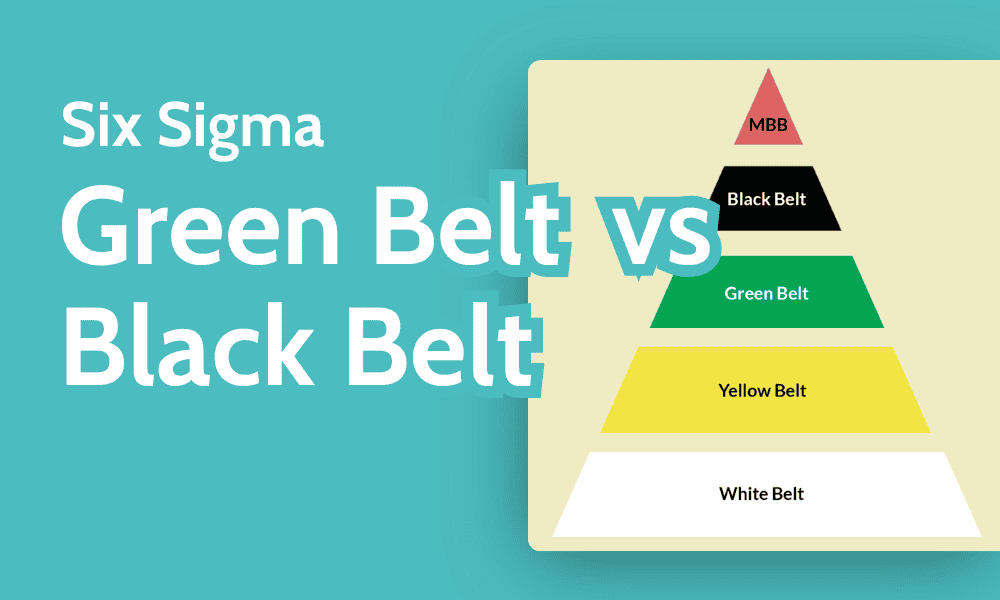Courses
Profil
Cloudwards Video Courses New
Cloudwards.net may earn a small commission from some purchases made through our site. However, any earnings do not affect how we review services. Learn more about our editorial integrity and research process.
We love talking about the best project management software and explaining project management methodologies, as we know it helps many readers. With that in mind, we’ll look at Six Sigma methodology and Six Sigma Green Belt vs Black Belt certifications. These aren’t elements of martial arts, but rather tools to help you level up your project management game.
The benefits of Six Sigma are plentiful. It’s a useful approach for a range of project management styles, from traditional to Agile project management. The belts represent your knowledge of the Six Sigma methodology. As you ascend through the ranks, you can obtain better jobs, earn higher pay and gain your peers’ respect. We’ll cover all the belt levels later in this article.
At a Glance: Green Belt vs Black Belt Key Differences
Below, we’ll give you a quick overview of the core differences between the Green Belt and the Black Belt. Keep reading for a more detailed examination of these belts later on.
| Green Belt | Black Belt |
|---|---|
| Works on smaller projects | Manages larger projects |
| Understands the DMAIC model | Understands basic Lean principles |
| Leads Yellow Belts within a project | Leads Green Belts within a project |
| Trains lower-ranking belts within a project | Is a point of contact for key stakeholders |
What’s the Six Sigma Green Belt?
To obtain Six Sigma Green Belt certification, you’ll need to demonstrate strong problem-solving skills pertaining to project management. You must also undergo certified Six Sigma Green Belt training before completing a final exam. Candidates must demonstrate understanding of the “define, measure, analyze, improve and control” (DMAIC) model.
The Six Sigma Green Belt shows you have the knowledge and
skills to lead project processes and small projects.
To be eligible for the Green Belt, you must have at least three years of professional experience as a member of a Six Sigma team. Part of obtaining your Green Belt certification includes completing an exam. During the exam, you will need to earn a minimum score of 280 points out of a possible 400. The test is open-book and includes a range of multiple-choice questions.
Role: What Can a Green Belt Do?
Green Belts act in a supporting role to higher-ranking belts. They help with collecting data and presenting the results of analysis. The main goal of Six Sigma Green Belts within a project is to use data to streamline processes to help the project run smoothly and ensure everyone can achieve the overall objective.
What’s the Six Sigma Black Belt?
The Six Sigma hierarchy deems a Black Belt as someone who is an expert in Six Sigma philosophies and the role of Six Sigma tools in project management. They also display expert knowledge of leadership roles, team dynamics and the discovery of non-value-adding processes.

The Six Sigma Black Belt shows that you can lead teams and positively influence them.
To obtain Six Sigma Black Belt certification, you should be able to demonstrate team leadership skills and have an understanding of how to assign team members to different project roles. You’re also expected to have at least a basic understanding of Lean project management, as well as relevant work experience, which we’ll cover shortly.
Role: What Can a Black Belt Do?
A Six Sigma Black Belt has more of a management role and oversees Green Belts’ work. This includes ensuring Green Belts are gathering the relevant information required to improve project-wide processes. Black Belts also serve as a point of communication for key stakeholders and can communicate the overall status and health of the project.
The Six Sigma Belt Levels Order
The journey to Six Sigma mastery entails a path of five belts. The journey begins with the White Belt and progresses through to the Master Black Belt. Below is a brief overview of what to expect with each belt.
- ⬜ White Belt: There are no requirements to obtain a White Belt. At this level, you will learn about the history of Six Sigma and how to use it to create customer value. In addition, you’ll learn about the PDCA method, which is also known as the Deming method.
- 🟨 Yellow Belt: Yellow Belts must understand Six Sigma basics. Yellow Belts can join project teams to improve low-level processes. To obtain a Yellow Belt, you must score at least 140 points out of 200 on your certification exam.
- 🟩 Green Belt: Green Belts should display advanced problem-solving skills and use the DMAIC model. You must complete a two-hour exam to obtain a Six Sigma Green Belt.
- ⬛ Black Belt: Six Sigma Black Belts are experts who manage lower-ranking belts. The Six Sigma Black Belt includes three tiers, and you’ll need to apply for each one individually.
- 🥋 Master Black Belt: A Master Black Belt is a top-tier expert in the Six Sigma Body of Knowledge. They must have four years of experience as a Six Sigma Black Belt and score at least 540 points out of 600 to pass the final exam.

There are five belt levels in the Six Sigma program.
Career Benefits
Each belt offers several career benefits. Below, we’ll outline the benefits of Green Belt and Black Belt certification, including the salary range you can expect with each one.
How to Choose the Right Six Sigma Belt Level
Ideally, you want to earn each of the Six Sigma belts, starting with the White Belt. This will help you gain knowledge and understanding at all levels, and avoid wasting money on a certification you are not ready for. However, if you have gathered knowledge through work experience and meet the criteria for a higher rank, you can skip the lower-ranking Six Sigma belts.
How Do I Get a Six Sigma Certification?
You can obtain Six Sigma certification through many educational bodies, but The Council for Six Sigma Certification is one of the best choices. Most belt certifications require you to complete an exam and have relevant professional experience. The good news is you can complete Six Sigma training before taking each exam.
How Much Does a Six Sigma Certification Cost? Green vs Black Belt
Entry-level certification is free; however, other certification levels entail a fee of anywhere from $99 to $665, depending on the ranking.
Six Sigma vs Lean Six Sigma
Six Sigma and Lean Sigma are not the same, but the differences are easy to understand. With Six Sigma project management, the goal is to eliminate process variations and defects and to improve process controls. Lean Six Sigma differs in that the goal is to reduce waste and costs, improve customer value and strive towards process improvement.
Final Thoughts
With a clear understanding of the differences between the Green and Black Belts, you can decide which certification matches your level of experience. Green is ideal for those who want to increase their standing as part of a project team, while Black is for those who wish to lead projects. We recommend completing the necessary training before taking any certification exam.
If you’re looking to improve your understanding of other areas of project management, we suggest taking a look at our explanation of the theory of constraints. If you’re in the market for tools to help improve your project management process, check out our selection of the best free project management software.
Did you find this guide useful? Which Six Sigma belt will you obtain? What advice would you give to someone looking to obtain Six Sigma certification? Let us know in the comments. Thanks for reading.
FAQ: Six Sigma Belts
-
No, a Green Belt is not required to obtain a Black Belt. There are also no prerequisites to study for and obtain a Black Belt other than paying the assessment fee.
-
There are several benefits to obtaining Green Belt certification. You can gain more responsibility within a project, access more career opportunities and earn an average salary of $85,000 per year.
-
Green Belts are one step below Black Belts in the Six Sigma hierarchy.
-
The highest-ranking Six Sigma belt is the Master Black Belt. The Master Black Belt proves that you have an expert-level understanding of Six Sigma and can help you attain high-level professional opportunities.
Sources:
- The History of Six Sigma — Six Sigma Online
- Six Sigma Certifications — The Council for Six Sigma Certification








